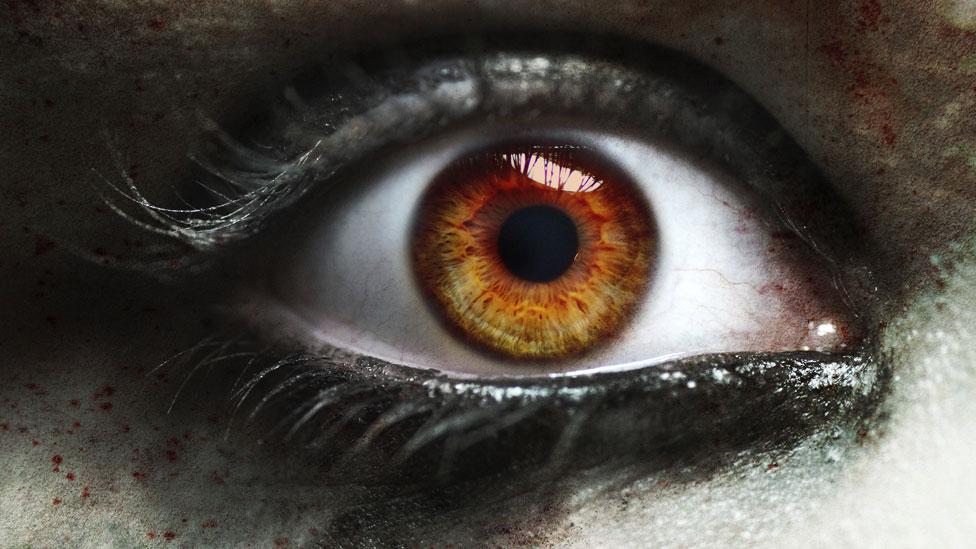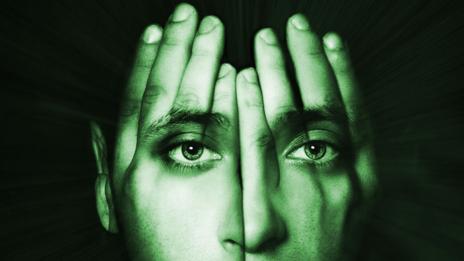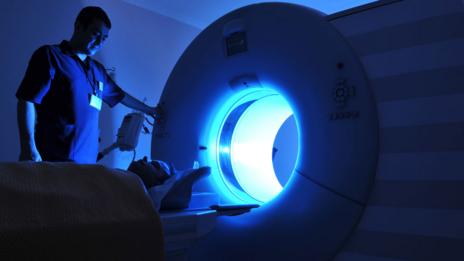From the BBC Future site.
Hypnosis: The day my mind was 'possessed'
In Depth | 3 July 2014
David Robson

Scientists are using hypnosis to understand why some people believe they’re inhabited by paranormal beings. To find out more, David Robson discovered what it’s like to lose his mind.
I am lying on my back and trapped in a gleaming white tunnel, the surface barely six inches from my nose. There is a strange mechanical rumbling in the background, and I hear footsteps padding around the room beyond. In my mounting claustrophobia, I ask myself why I am here – but there is no way out now. A few moments later, the light dims, and as the man speaks, my thoughts begin to fade.
“The engineer has developed a way of taking control of your thoughts from the inside. He does this because he is fascinated by mind control, and wants to apply the most direct method of controlling your thoughts. He is doing this to advance his research into mind control. You will soon be aware of the engineer inserting his thoughts.”
A strange serenity descends as I realise that soon, my will won’t be my own. Then the experiment begins. I am about to be possessed.
The man who will soon take control of my thoughts is Eamonn Walsh, a psychologist who uses hypnosis to investigate psychoses at the Institute of Psychiatry in London. The idea is to turn healthy subjects into ‘virtual patients’ suffering full-on delusions, such as being possessed by a paranormal entity, allowing the scientists to understand the underlying illness in a new way, and potentially find treatments
The scientists are understandably keen to distance themselves from stage hypnotists. “It’s not flaky, it’s not for entertainment – we’ve got carefully specific research goals,” says Mitul Mehta, who collaborates with Walsh on these studies. It’s a bold idea, but can it possibly work? And what does it feel like to lose total control of your mind?

I confess that I was a little nervous when I entered the lab earlier that day. Hypnosis research has a somewhat murky history; one early experiment very nearly ended in murder. The researchers in question were two of the most prominent doctors in France at the beginning of the 20th Century: Jean-Martin Charcot, now considered the “founder of modern neurology”, and Georges Gilles de la Tourette, who is most famous for the disease that bears his name. They studied cases of “hysteria” – in which patients were suddenly unable to feel or move their limbs, for instance, despite no observable injury. Both doctors believed that the disorders might share certain characteristics with hypnosis – a hypothesis they tested by showing that people with hysteria are more susceptible to suggestion than healthy subjects.
They soon veered into less reputable territory, however. At the time, newspapers reported tales of criminals “mesmerising” innocent people to carry out nefarious deeds. Despite his scepticism about the reports, Gilles de la Tourette decided to hypnotise a hysterical patient, Blanche, to see if it might be possible. Placing her in a trance, he showed Blanche a ‘poisoned’ glass of beer and asked to feed the poison to another man, known as Mr G. Blanche happily complied, kissing Mr G as she did so, before he feigned death. She later denied all knowledge of the apparent murder.
 Neurologist Jean-Martin Charcot is depicted demonstrating hysteria in a woman called Blanche Wittman (Wikipedia/CC-PD-Mark)
Neurologist Jean-Martin Charcot is depicted demonstrating hysteria in a woman called Blanche Wittman (Wikipedia/CC-PD-Mark)
Perhaps it was this cavalier attitude that nearly cost Gilles de la Tourette his life. One day in December 1893, he was confronted at home by another one of his hospital’s patients, a 29-year-old woman named Rose Kamper-Lecoq. Claiming that her hypnosis sessions had irretrievably altered her will, she whipped out a pistol and shot at him three times. Only one of the bullets penetrated his skull, but he was well enough to write to a friend the same evening, concluding in a wonderfully blasé fashion: “quelle drôle d’histoire” – “what a funny story”.
Kamper-Lecoq’s story is all the more striking in light of today’s research. Although her violence almost certainly wasn’t caused by hypnosis, it seems to have stemmed from many of the delusions that psychologists like Walsh are now unpicking with their virtual patients. She was said to be sure that Gilles de la Tourette was in love with her – a disorder known as “erotomania” – and she also (falsely) believed that someone was controlling her mind remotely: exactly the kind of mind possession I signed up for. I just hope it doesn’t end with me putting a bullet in somebody’s skull. Georges Gilles de La Tourette was shot by a disgruntled woman he'd hypnotised, as this French newspaper depicted (Wikipedia/CC-PD-Mark)
Georges Gilles de La Tourette was shot by a disgruntled woman he'd hypnotised, as this French newspaper depicted (Wikipedia/CC-PD-Mark)
Before I was possessed, I first was tested for my “hypnotisability”. The procedure usually involves some kind of guided relaxation, followed by a series of suggestions that are meant to warp your perceptions and behaviours. I was told that I could hear a fly buzzing around my head, for example; later, the researcher said that a balloon would slowly lift my arm into the air. From what I can remember, my arm felt light, as if it were filled with helium, and before I had realised it, it was already floating upwards. The buzzing of the “fly”, meanwhile, felt like the flashes of images and voices you might begin to hear if you are very tired and about to drop off to sleep – you realise they aren’t real, yet they are perceptible all the same. Based on my responses, I scored 10 out of 12 – a degree of suggestibility that puts me in the top 10% of the population.
Given the reliance on subjective reports, the authenticity of hypnotic behaviour has been a matter of debate. “Some believe that hypnosis is pure fakery, whereas others believe it is a genuinely altered state of consciousness that can produce profound changes in perception, thought, and memory,” says Rochelle Cox, a cognitive scientist at Macquarie University in Australia. Some people are easier to hypnotise than others (Thinkstock)
Some people are easier to hypnotise than others (Thinkstock)
Although I didn’t feel like I was faking it, I ask Walsh whether he is ever concerned his subjects are pretending. He agrees the possibility casts an ever-present shadow over the research. “Anytime you submit a study to a journal, it’s one of the reviewers’ favourite questions,” he says. But advances in brain scanning have begun to lay those concerns to rest. While in the brain scanner, the hypnotiser might tell the subject to see a black and white photograph in colour, for instance – and you would see the areas for colour processing bursting into action as if they were actually looking at a real-life scene. Importantly, when the same subjects are simply asked to ‘pretend’ to experience, or imagine, those feelings, you don’t see the same activity. Such results have converted many sceptics.
Along the way, the researchers have edged closer to understanding what causes the hypnotic state in the first place. It seems that hypnotic induction turns something like a dimmer switch in the brain’s frontal lobes. These regions are thought to generate “higher-order thoughts” – reflective awareness of your own wants and needs and motives. Take that away, it seems, and you begin to do and feel things without realising why. That might explain why students tanked up on alcoholic drinks – the equivalent to two pints of beer – score much higher on the standard hypnotisability tests; alcohol is known to dampen frontal lobe activity, says Zoltan Dienes at the University of Sussex in Brighton, UK.
Why some people naturally drop into that state, while others find it harder, is an open question, however. Twin studies suggest it can be passed through the generations, and there’s some evidence it can be inherited. Importantly, people tend to retain the same score throughout their life, so it could just be another fundamental feature of our minds like IQ. Hypnotism can be used as a treatment for all sorts of medical conditions (SPL)
Hypnotism can be used as a treatment for all sorts of medical conditions (SPL)
Along these lines, much of the work so far has been devoted to studying whether hypnotic suggestion could be used in place of painkillers. Randomised controlled trials have also investigated whether hypnosis could reduce stress, help cancer patients with their fatigue during chemotherapy, treat irritable bowel syndrome, and even boost students’ learning of new skills.
Around the year 2000, however, the research began to take a more macabre turn: rather than taking the ill and making them better, psychologists used it to plant delusions in the minds of the healthy. Like Gilles de la Tourette’s studies a hundred years before, one of the first investigations was inspired by a patient suffering from ‘hysterical paralysis’ – the sensation that she could not move her left leg, even though there was no physical disability. To see if they could recreate the disorder, researchers hypnotised a subject to feel the same sensations, and placed him in a brain scanner. The results – published in the medical journal The Lancet – revealed exactly the same pattern of activity in his brain as the hysterical patient, strongly supporting the possibility that hypnosis could be used to test hypotheses about real mental conditions.
Since then, psychologists have used it to conjure many other types of delusion, including erotomania, Capgras syndrome – the sensation that your loved ones have been replaced by a doppelganger – and mirror misidentification, in which people fail to recognise their own reflections. “Patients may cover up all the mirrors in their house because they think the stranger is following them around,” explains Cox, who carried out many of the studies. Hypnosis, she says, can produce almost identical symptoms. “Both are compellingly real, believed with conviction, and resistant to rational counterargument.” It is completely reversible, the researchers reassure me – all subjects leave the labs free of delusion. Some people see a stranger in a mirror instead of their own face (Thinkstock)
Some people see a stranger in a mirror instead of their own face (Thinkstock)
Hypnosis lets the scientist create the symptoms at will, while also manipulating the conditions to try to see what underlying cognitive processes might be misfiring in order to conjure the delusions. Eventually, you might even be able to use the hypnotised subjects to test certain kinds of therapies – before you risk them on mentally ill patients.
Needless to say, some of the researchers are sceptical of the benefits of this approach. Dienes, for instance, agrees that these virtual patients may be useful for the ‘hysteria’ disorders – like the limb paralysis. But he is sceptical that you can hypnotise somebody to experience the highly complex and terrifying psychosis of a disease like schizophrenia.
Walsh readily acknowledges that it can’t recreate every aspect of an illness, but sees hypnosis as a complementary technique that adds to the understanding gleaned from direct observations of real patients. “It’s is just another way of looking at things – you’re shining a light on the darkness from a different angle,” he says.
Before I allowed myself to be possessed, Walsh showed me two prints by the late 16th Century painter, Caravaggio, to make a point about the patients who believe they are controlled for real. One shows Saint Matthew as an “illiterate oaf”, his feet still dirty from his work in the fields. An angel is guiding his hand as he writes the gospel. In the second, “he’s been promoted” – Saint Matthew is clean and has a halo. The angel is now depicted above his head, whispering God’s words into his mind. Two Caravaggio paintings that capture the delusion of mind-control: a guided hand (left) and whispered commands (right) (Wikipedia/Paul Hermans/CC-PD-Mark)
Two Caravaggio paintings that capture the delusion of mind-control: a guided hand (left) and whispered commands (right) (Wikipedia/Paul Hermans/CC-PD-Mark)
The two paintings, he says, perfectly depict the two different ways in which patients experience possession: either they feel that another being is controlling their movements, or that another person is directly planting thoughts into their head. Such feelings may be due to mental illnesses like schizophrenia or psychotic depression, or the result of cultural practices such as shamanism that might lead people to feel like they are channelling another spirit, which may also be triggered by a ‘dissociative’ state similar to hypnosis. I will experience both, he says.
One of the team’s biggest challenges was to create suitable hypnotic suggestions that could feasibly manifest in a delusion, without being too scary. Possession stories often reflect contemporary culture of the day – in the Industrial Revolution, people believed the factory looms were directing their behaviour; Kamper-Lecoq’s delusions were influenced by her brushes with ‘mesmerism’; and in the early 20th Century, it was thought to be radio antennae planting ideas into people’s head. So rather than creating a spiritual demon, the team told a story of an ‘engineer’ doing research into mind control – a tale that isn’t too menacing, but which neatly draws on today’s fears about privacy and individual liberty. I was hypnotised inside a claustrophobic fake scanner similar to this one (Thinkstock)
I was hypnotised inside a claustrophobic fake scanner similar to this one (Thinkstock)
Walsh puts me in the shell of an old brain scanner, which is often used to test procedures before hiring the real thing. At first I feel crushingly claustrophobic, but I soon forget those feelings as he counts down from 20, leading me gently into the hypnotic state. With a pen in my hand and a sheet of paper on my lap, my task will be to hear a word and finish the sentence under three different scenarios; first Walsh tells me that the engineer is whispering the words to write directly into my brain; then that he is able to direct the movements of my hand; and finally that the engineer is in complete control of both my thoughts and movements.
The first scenario had only a minimal effect: I seem to have to wait a little before the words come suddenly, as if from nowhere, but it doesn’t feel so different to my normally sporadic mind. But when Walsh instead tells me that the engineer has now taken over my movements, it is much more noticeable: my hand seems to move in a jerky, mechanical fashion, and it feels like my fingers are dancing to their own tune. It is then that I also begin to get flashes of the engineer himself – who I picture to be a hunched man with a wide grin and a long, grey pony-tail. By the time we reach the third set of suggestions – where Walsh tells me that the engineer will now control my hand movements, and my thoughts – the engineer’s power over me becomes much more vivid. My writing becomes faster, and more intense, and I get the distinct feeling that I am watching myself, from the outside. At points it feels like I can almost hear the engineer directing his thought-control machine. It is only when Walsh ends the session, and counts back up to 20, that I fully realise how strange the sensation was: a little like the moment of lucidity once you awake from a fevered dream. The strange stream of writing I produced during my possession (Stephen Dowling)
The strange stream of writing I produced during my possession (Stephen Dowling)
When I tell Walsh about my impressions, he says they are pretty much in-line with his other subjects. As one person put it: “I felt as if my hand had been made of metal.” While many, like me, pictured the engineer visually, others felt he was more amorphous: “Like a presence, as opposed to something that one can see”.
So far, these investigations have suggested a few networks of brain regions that might lie behind these delusions. When a person believes that their hand is being controlled by another being, you find an abnormally high connectivity between the motor areas that control movement, and regions that help us understand another’s motives and actions. Conversely, when the subjects were told that the engineer was inserting the thoughts into their mind during the writing task, they had much lower activity in the language areas of the brain – perhaps because they were less conscious of the generation of the words.
In some scenarios, they found increased activity in the areas involved in ‘error detection’. In normal everyday life, these regions normally keep track of our movements and the way they are executed, and then fire if things don’t go according to plan – like when you trip up. So it’s possible that the heightened activity reflects the subjects’ feelings that their movements were becoming more unpredictable, as if they were no longer under their own control.
If the same regions of activity continue to emerge in further studies of hypnotic subjects and real patients, it might suggest new treatments. For instance, it might be possible to find drugs that specifically alter activity in the regions in question; alternatively, non-invasive brain stimulation could help correct any abnormal circuits – preventing the ‘error network’ from going into overdrive. The team are also interested in using neurofeedback – technologies that allow patients to view their neural activity on a screen, and correct it appropriately. “We are a few steps away from doing this,” says Quinton Deeley, who has run many of the experiments. “But we are at the threshold of doing it for anxiety and attention deficit disorder, and I don’t see why they couldn’t be applied to things like delusions”.
Away from mental health, it’s possible the work might shed light on more general phenomena. It’s possible that it could relate to religious phenomena – like the feeling of ‘talking in tongues’ or the kind of mass hysteria seen in the Salem Witch Trials. And possibly even what is going on the brain when we first conceive of an idea, and how it takes hold and guides our behaviour.
My brief period of possession has certainly made me more conscious of my own thoughts, and the strange ways they can seem to pop into your head. At least, I’m pretty certain that belief is my own… or is that just the engineer, guiding my hand as I type?
If you would like to comment on this, or anything else you have seen on Future, head over to our Facebook or Google+ page, or message us on Twitter.
No comments:
Post a Comment